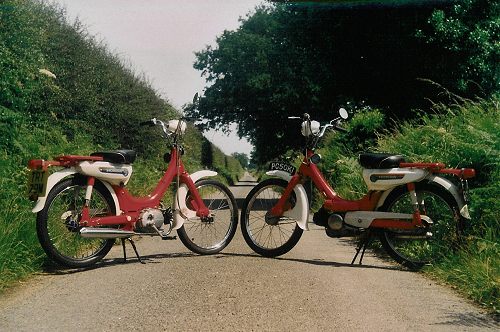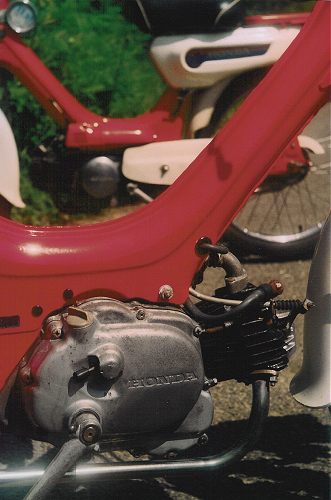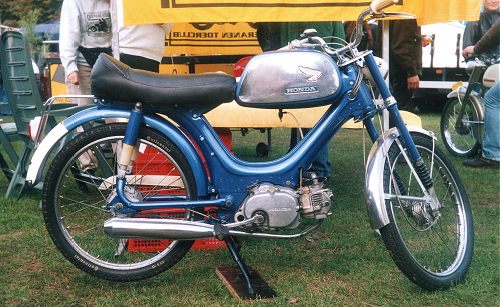 Go
to the Archive index
Go
to the Archive indexJust seeing the J-word in the title of the article is probably enough to have the traditionalists diving for the air raid shelters, but let's objectively test the evidence before condemning the subject. The claim lain before the membership today: Is there such a thing as Classic Jap? Standing in the dock in defence of this issue, the inscrutable Honda PC50. So let's look at the evidence: eligibility - well the model became listed as discontinued in February of 1977 so that makes even the last machines at least 26years old, and unquestionably qualifying under the NACC 20year rule. Neither does it feature footrests, kickstart, or the barely operable pedal arrangements of many of its period contemporaries - It's a proper moped with a truly effective cycling capability neatly engaged at the flick of a switch! In engine mode, it functions through a simple single gear and automatic clutch. Oh yes, and its Novio derivative became the last true 4-stroke pedal moped at its cessation in February 1978.
The PC50 is actually two machines sharing the same cycle parts, but fitting totally different engines. The first of the name featured an overhead camshaft motor derived from the Honda P50 motorwheel which ran from December 1966 to April 1968, being replaced by the PC50(OHC), which continued up to April 1970 when the OHC engine gave way to the OHV (pushrod) motor in the same cycle frame, and the new model being re-designated PC50K1. The cycle chassis comprises two pressed-steel halves welded together down the centre-line, with pressed steel leading link forks up the front and swing-arm suspension at the back. A deceptive rear mounted 3 litre petrol tank is actually only single sided on the left, as a toolbox mirrors its form to starboard. The tank and toolbox assembly is trimmed by a useful pressed steel rack with inverted pegs that easily engage the traditional bungee straps to tie things on, or sturdily mounts a moulded box to put things in. The speedometer was a standard fitment to all machines, which came in a spectrum of imaginatively titled colours from 'Rat Grey' through to 'Mirage (light) Blue', 'Scarlet Red' (nice and sharp), 'Bonny Orange', 'Varnish (dark) Blue', and 'Cloud White' for the non-metal parts. But times were changing in other ways, and the Japanese were also leading the introduction of applications for alternative engineering materials: plastic! You can still hear the echoes of those traditionalist voices in the Hall of Doom, "You can't make a motor cycle out of plastic!" How wrong they were. The PC features plastic mudguards, headlamp (OHC models), chainguard, rear suspension shrouds, toolbox cover and air filter trim.

A pair of PC50s
But getting down to business, the real heart of a machine is its engine, and these dainty 4-strokes had perfect little tickers. They offered complete oil-tightness with unburstable thrashability and, afterwards, they'd still run like your wristwatch! Simple, clean, quiet, it makes you sick! If British industry had produced the PC motor at the time, we'd all be right proud of it today! So how was it done? Detailed design, high volume production, precision machining, and above all - totally functional. There's no exotic specification to it either, with the simple automatic clutch driving a fixed ratio, splash oiling to most of the motor excepting a small pump to the parallel valves, and 8.5:1 compression ratio. The coil ignition features no advance-retard mechanism, and even secures in fixed timing position, leaving no more than fine adjustment to be made by varying the points gap, and only returning its sharpest performance by precision setting to strobe. Engine output is rated as 1.8bhp @ 5,700rpm, and carburation served by a 14mm Keihin with a direct shutter choke operated on a simple side lever. There's an easily switched little toggle lever on the right engine case, which engages the engine in one position and pedal drive in the other. While the engine drive is switched on you cannot push the bike forward without the motor turning over, but you can still manoeuvre the machine in this mode by engaging the decompressor.
Conventionally adopted cold starting practice is on the stand due to the need to reach down to shut off the choke lever. Once started, the automatic clutch allows the bike to be readily nudged onto its wheels for the off. Opening the throttle the PC labours steadily away on its automatic clutch, but a nudge on the pedals in this phase is much appreciated by the motor. The initial impression is how much more lazy and relaxed the muffled 4-stroke engine sounds by comparison to the usual frantic 2-strokes, but as the speed picks the individual firing notes blend into a characteristic little revvy snarl that so typifies the old Hondas. The motor unit pulls quite strongly in its mid range, then fades to a ceiling around 30 to 35mph according to conditions, load carried, and state of tune. It typically appears completely unphased by constant full-throttle use, and if it is felt performance is falling off, this can usually be restored by a valve job and new piston rings. Regular oil changes are absolutely vital to maintain engine condition, and with an oil capacity of a mere 0.8 - 0.9 litre for the OHC model and 0.75 litre for the OHV, there's little excuse to let the duty slip.
The early OHC models only appeared to have developed a total 6V × 15W generator output, which became uprated to 23W with the OHV motor. The mysterious dual filament rear bulb was to accommodate a stop-light in some countries (not fitted in the UK), and for some markets, even indicators were equipped!

The OHV engine unit
The wheel hubs appear to feature worryingly minuscule brakes, but thanks to precision engineering, they usually maintain adequate function and rarely require any more concern than periodic lining replacement. Actual braking operation becomes somewhat compromised by the soggy material properties of the original plastic levers, however Honda only supply metal ones as replacements now, and these much improve the performance and feel. Both front and rear suspension tend to give a soft bouncy ride, but the leading-link front forks do display some disconcerting tendency to rise-up under braking. Only a little unpleasant in the dry, but watch out in the wet, particularly on greasy roads! So much positive stuff, but what's the downside? Well, the speedo drive is very prone to failure; it's hard to find many machines now that they actually work on. The centre stand pivots commonly wear slack and the silencer may tend to internal rust or metal fracture. It's essential to maintain greasing at the leading link suspension points or horrible wear develops within the bushes and pins, and these service kits are now becoming increasingly difficult to source. Overall, the PC is well made, simple and reliable. Widely available and still remarkably cheap, it's one of those little bikes that even today is still likely to deliver many more years of good service while also having that rare moped feature of 4-stroke character.
The ultimate PC never washed up on our shore, but sold on the continent where it was listed as the PS50. This was introduced as a Sports variant of the OHC machine, having 3-speed twist change and manual clutch, motor cycle style petrol tank, dual seat and telescopic forks (Currently changing hands around €500 in Holland, if you fancy an import). Later on, OHV versions were also listed for the PS50 - and if PC50 owners here have ever wondered what the two grommet-blanked holes on the RH side of the frame just above the clutch cover are for? This is where the gear change cables exit the frame on the PS models.

OHC Honda PS50L pictured at Nationaal Veteraan Treffen at Woerden in
Holland.
One could say that it's a pity the PC was made in Japan, but in truth, it's probably more a shame it wasn't made in England!
Next issue and the NACC time machine stays firmly in the 1970s, but stops off on its way home from the Far East, to compare wares from some of our colleagues across the Channel. It's a double test and The Europeds are Coming: from France, and ... Belgium!
First published, August 2003